Jay Fisher - Fine Custom Knives
New to the website? Start Here

"Cassiopeia"
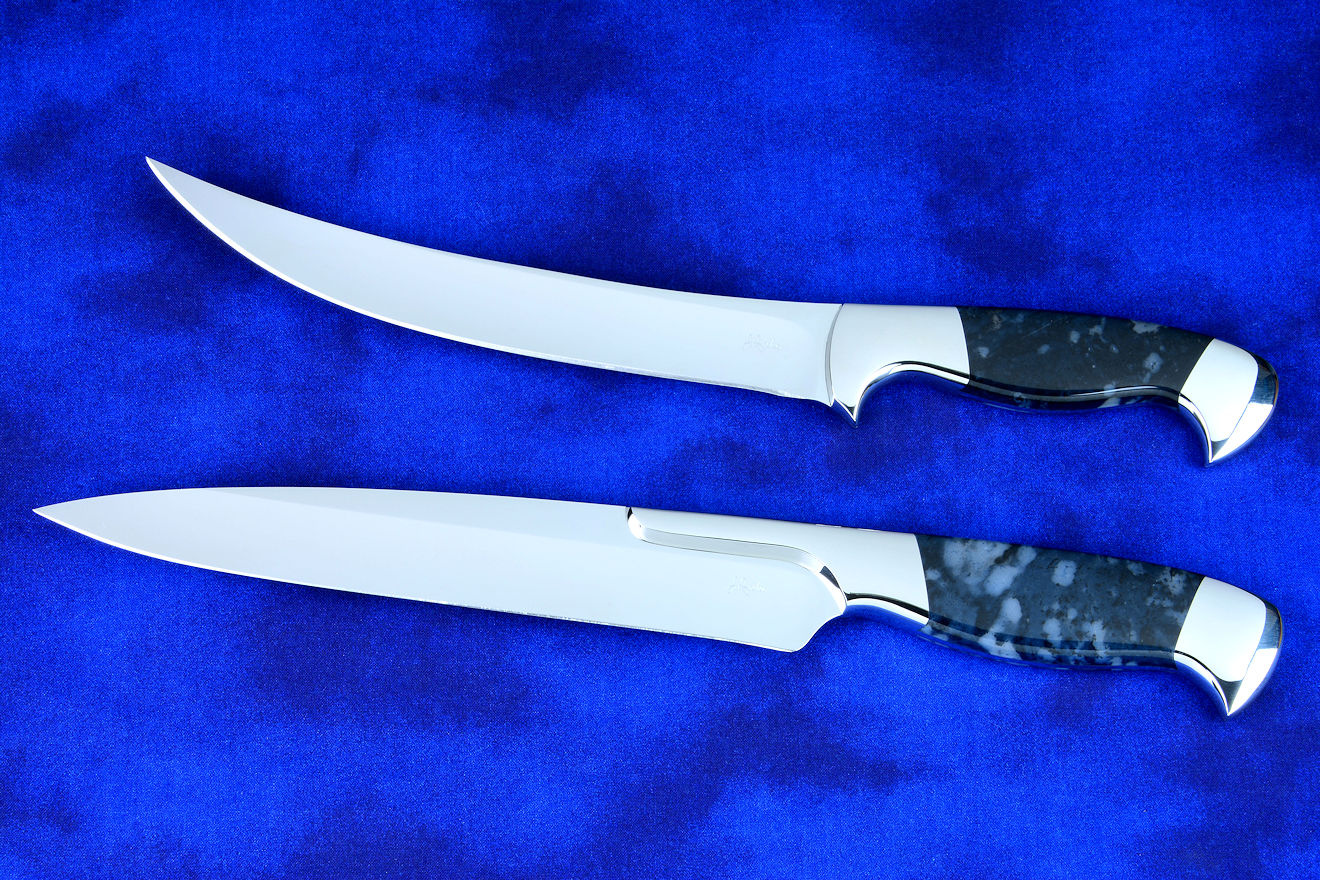
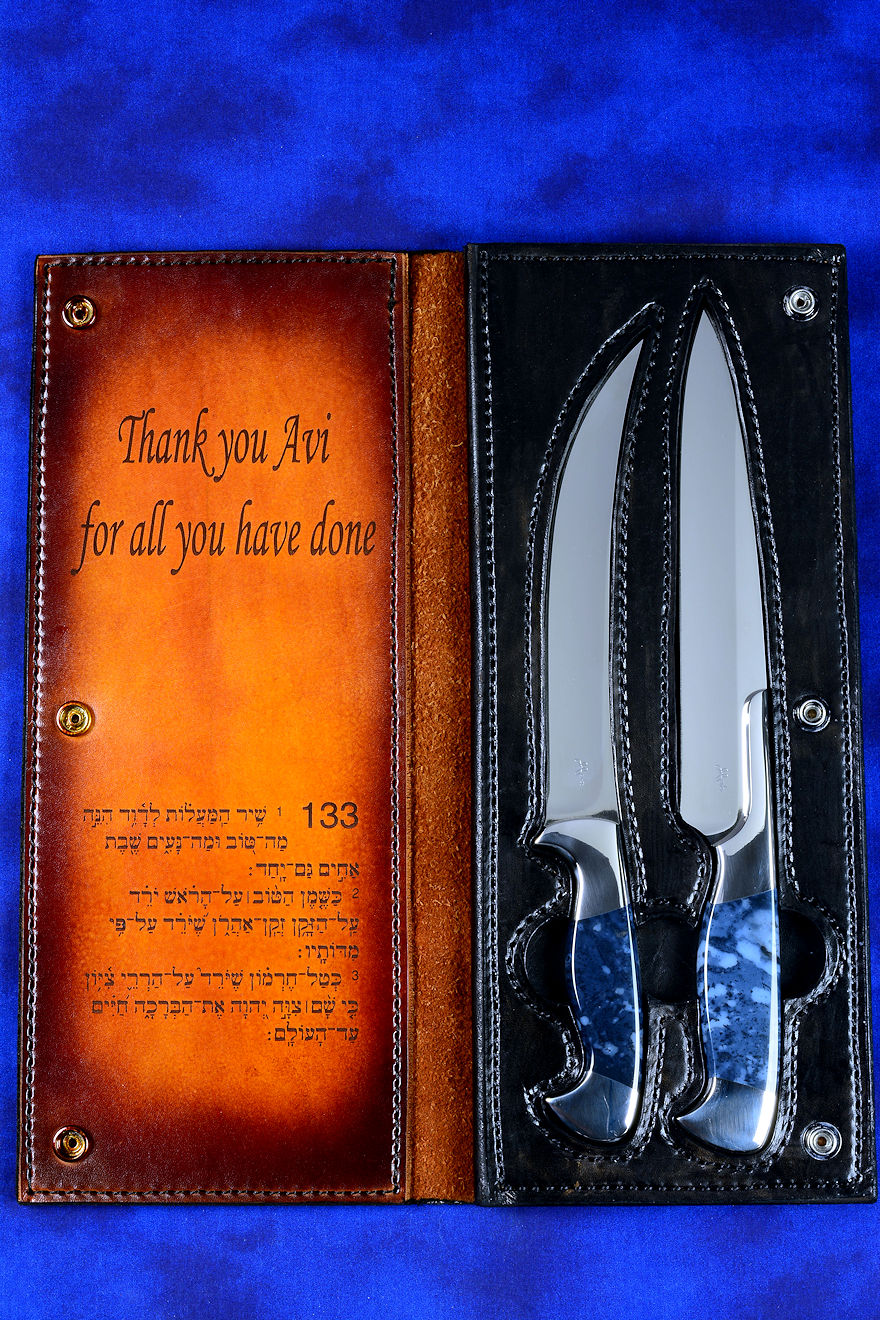
Beyond simple tools: fine instruments and professional works of art.
Whether at use in the professional kitchen or in processing barbeque, this pair of knives are an extremely well-made, useful and beautiful pair of instruments that will last for generations. In this set, I included a very strong, straight slicing and utility knife in my Bordeaux pattern, combined with my Courbe trimming and boning knife.
This pair of knives qualifies for what is casually identified as a Barbeque Set, but it is so much more. These are professional grade knives, and both designs are crossovers that can be applied to a large range of cutting activities in the kitchen by the chef. There is no reason knives of this caliber should be regulated to a narrow range of tasks, and I'm committed to making wide-ranging functional crossover designs, the first choice and best knives for the job.
I've used premium materials, an ultimate heat treatment, finish, and fitting, to create this useful and dependable pair. This is one of the very finest chef's pair of knives you will ever see, truly one of the very best ever made, representing my commitment to the science and art of knifemaking and chef's knives.
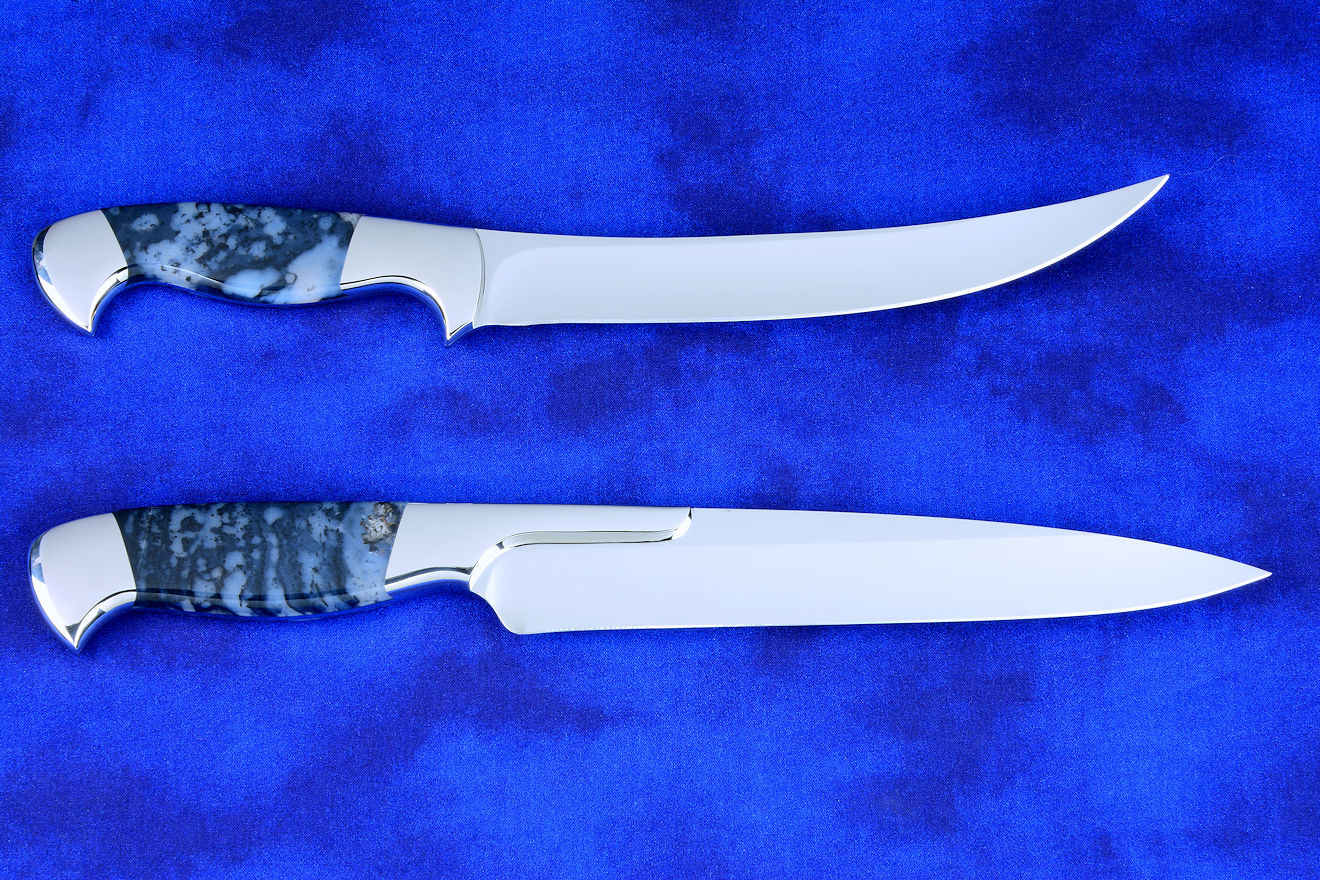
440C high chromium hypereutectoid martensitic stainless steel is an absolutely excellent steel for the professional chef. The reason this steel excels is because it's a martensitic stainless steel, forming an incredibly strong microstructure of martensite, the acicular, hard crystalline allotrope of the best tool steels. It also can be treated to form profuse carbides: iron carbide, chromium carbide, molybdenum carbide and multi-element carbides. These intricate crystalline structures offer incredible wear resistance and high strength along with excellent toughness.
When properly heat treated, 440C is the most corrosion-resistant of all of the high alloy martensitic stainless steels, with little to no chance of corrosion, even in the acidic and corrosive environments of the kitchen. It does not form these microcrystalline components easily; it takes extremely complicated heat treatment to bring this out. While it can be conventionally heat treated, the difference between conventional processing and a highly sophisticated processing of this steel results in night and day difference in performance and durability. Proper heat treating is paramount, resulting in superior edge retention, toughness, strength, and corrosion resistance.
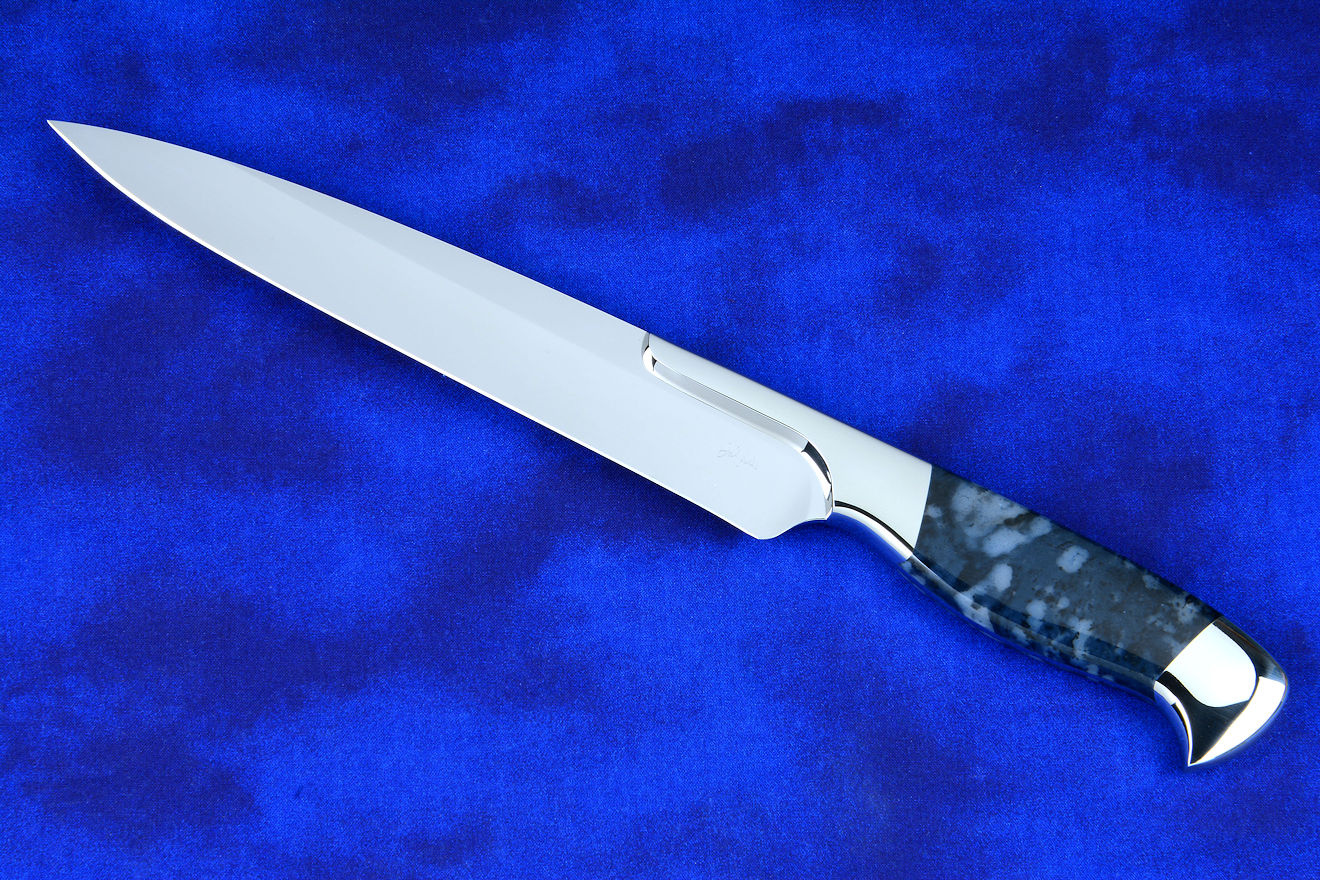
In order to bring this steel to its zenith of condition, I perform a proprietary heat treating process I call "T3." The technical aspects of this "tertiary third" formation of carbide structure is not a simple process. It takes over a week long, consists of 33 individual specific steps accomplished with high accuracy furnaces working at 1900°F, cryogenic equipment working at -320°F, and numerous staged and ramped process parameters. One small mistake will yield a less than optimum blade, and I'm determined to create the very finest knives made in the world today. Consequently, no other knifemaker, no factory, no machine shop, no heat treating facility will recreate the incredible condition of this blade steel.
The Bordeaux in this set is tempered to HRC 60, for a very hard, durable and stiff blade. This is a professional blade that has an incredibly thin cutting edge, with thick, strong spine to support it, and a deep hollow grind that gives this blade an incomparable slicing, utility, and cutting potential.
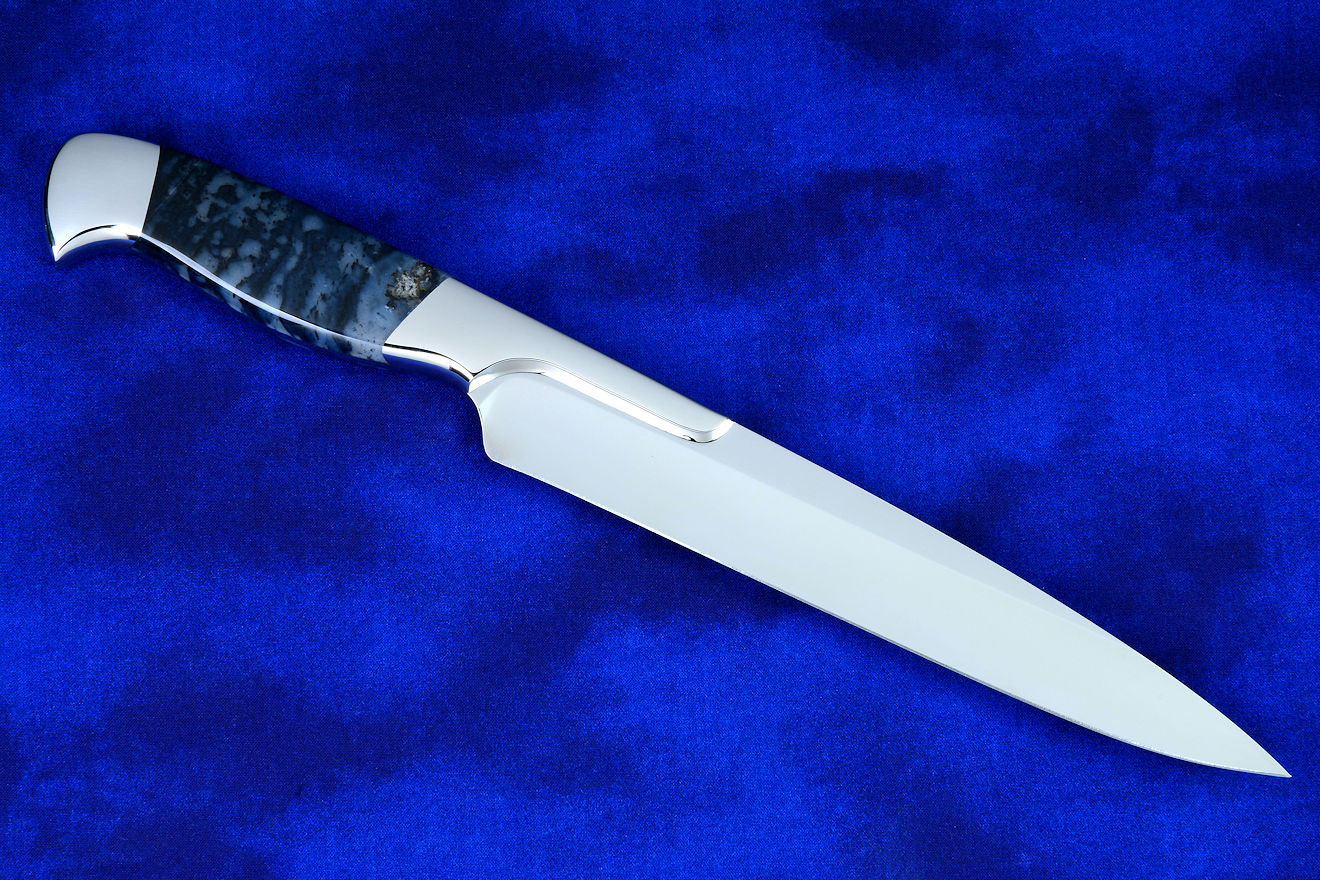
The Bordeaux has a very unyielding character. This is not a flexible blade; the heavy spine is 0.129" (3.3 mm) thick. This—combined with the lengthy heat treatment regime—means that there is no movement in this stiff, large blade, apart from the minimal flexibility at the very tip of the point. The hollow grind of the blade is what I define as a severe grind, similar to what is seen in a straight razor. The hollow geometry is established with a 12" diameter hollow grinding contact wheel. Rather than have substantial thickness at the cutting edge, this knife has a 0.014" (0.36 mm) thickness just behind the cutting edge. This is incredibly thin, the thickness of four sheets of paper.
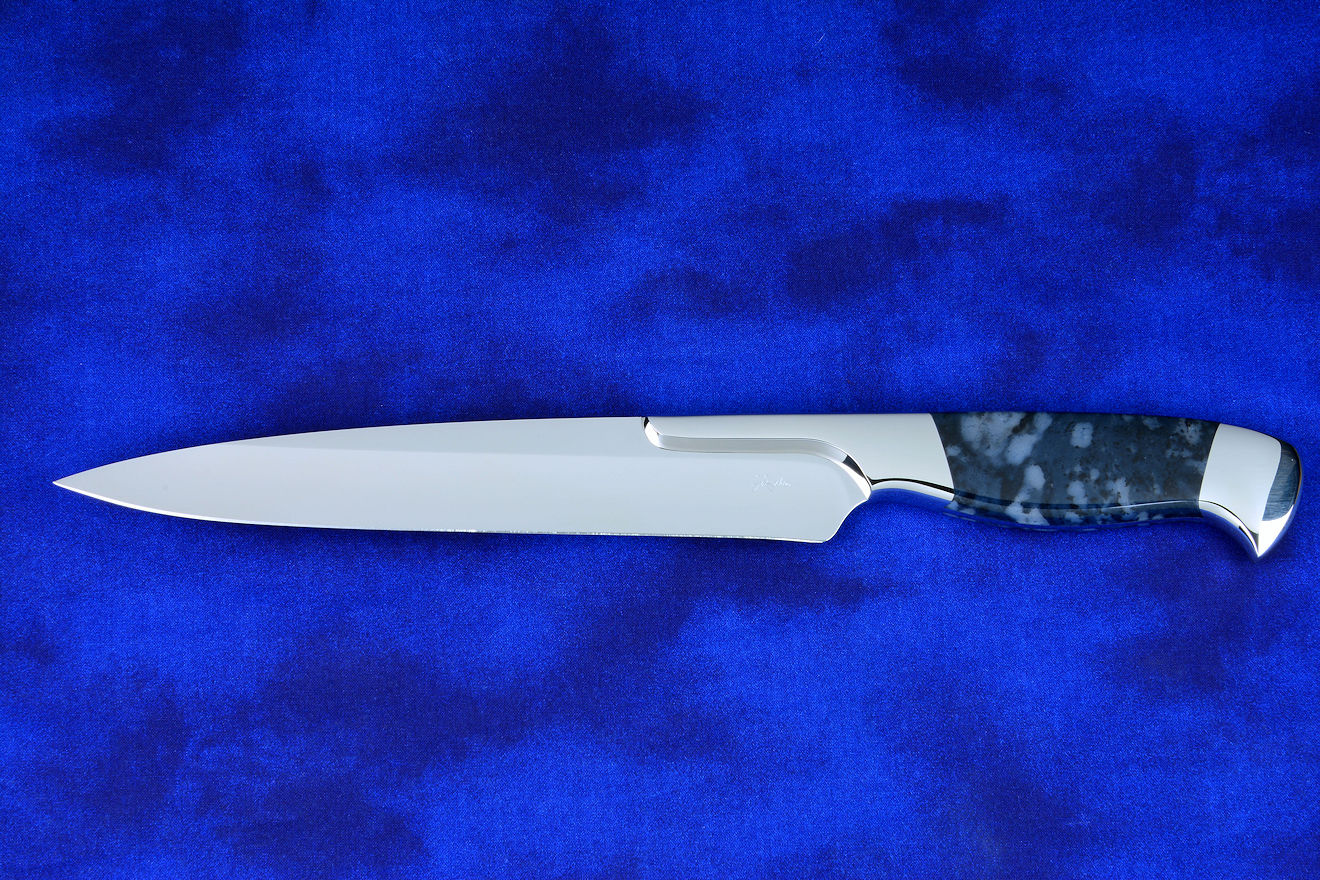
One of the most notable features of the Bordeaux is the long, extended front bolster. It's made of 304 stainless steel; this is the absolute best material for knife fittings, particularly for chef's knives. This is because it's a zero-care high chromium, high nickel austenitic stainless steel, the same steel used to make stainless nuts, bolts, and fasteners. It's also used to make heavy duty sanitary restaurant equipment, and it's absolutely Food Contact Safe.
Beyond the material, the geometry of the bolsters is unique; I know of no other fine chef's knife that has the extended front bolster. While not used on every knife, on the Bordeaux, this allows a certain and comfortable "pinch-grip" on the bolster, when light work is desired, or high control of the blade point only available in the pinch-grip style. The front bolster is secured with three through-tang zero-clearance pins for absolute mechanical security, and is sealed with food-safe sealant to the tang.
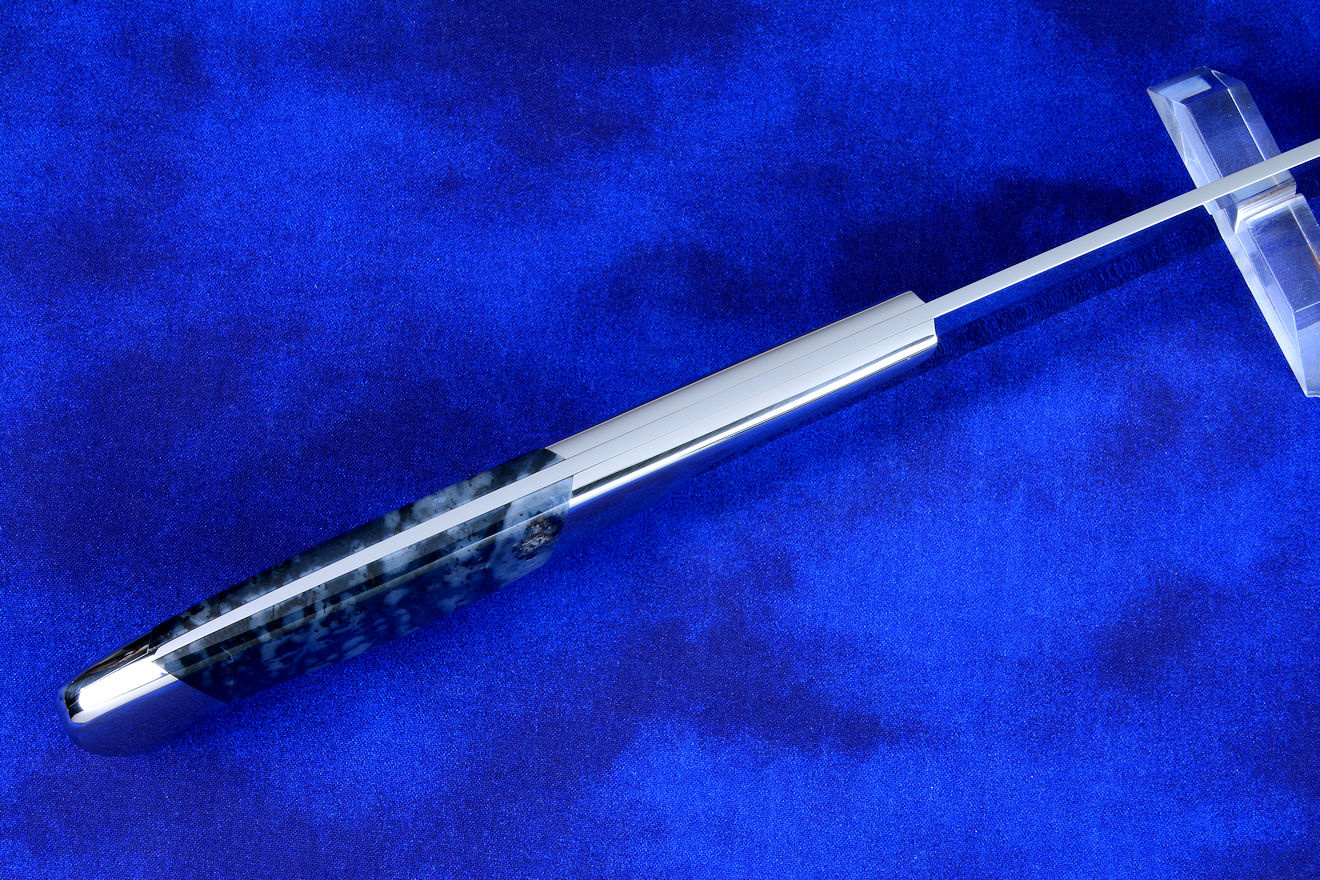
With versatility in mind, some chefs prefer to apply a light pressure for control by using the thumb or forefinger on the spine of the knife blade. On a thin blade spine, this can become uncomfortable. In the photograph above, you can see how much bearing surface is available for the thumb or finger on the extended front bolster. It's a wide bearing area, smooth and even, and comfortable to use. In the photo, you can also see the dovetailed front and rear bolster pairs, which positively lock the handle scales to the tang. The scales are bedded, secured, sealed, and solid.
In the photo above, you can see that the knife has a fully tapered tang, which is always seen only on the very best full tang knives. It's difficult to make an accurate tapered tang, which helps reduce weight in the handle without sacrificing strength, balancing the knife overall, and always indicating handmade excellence. I chose to forego any filework that would trap foodstuffs and debris, making the knife comfortable to hold and tremendously easy to clean.
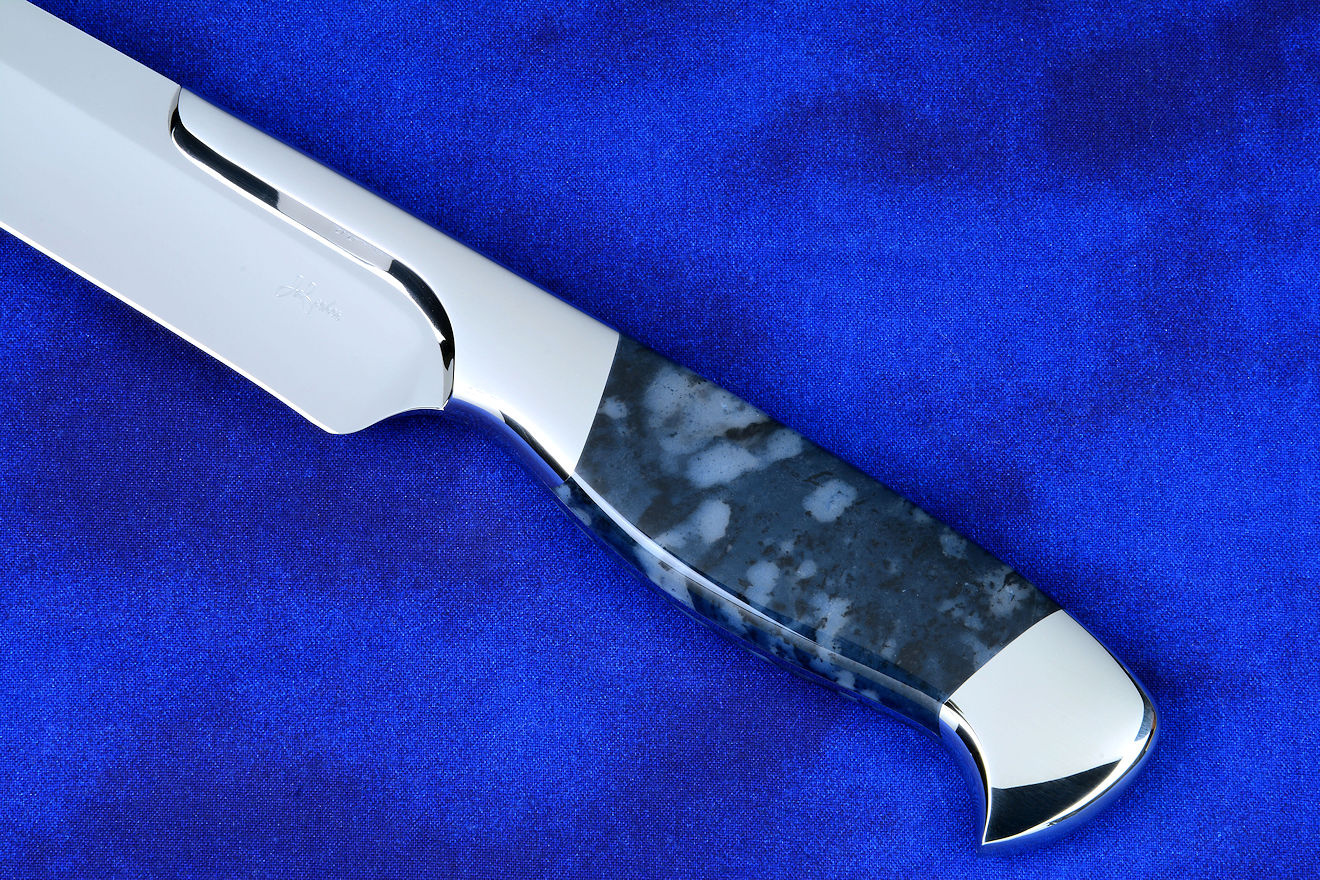
The photo above shows the obverse side handle detail. The knife has a small heel for a tight, compact form, typical for slicing knives. The heel has a rounded and gentle cutting edge transition, to make sharpening easy and smooth. The inside of the bolster curve is polished and tapered for cleanability, and all of the surfaces are contoured, rounded, polished, and comfortable. The belly in the handle, the heel, and the rear "hawk's bill" at the rear bolster help lock this knife into the hand. The "drop" curve at the butt and rear bolster assure comfort in the palm of the hand.
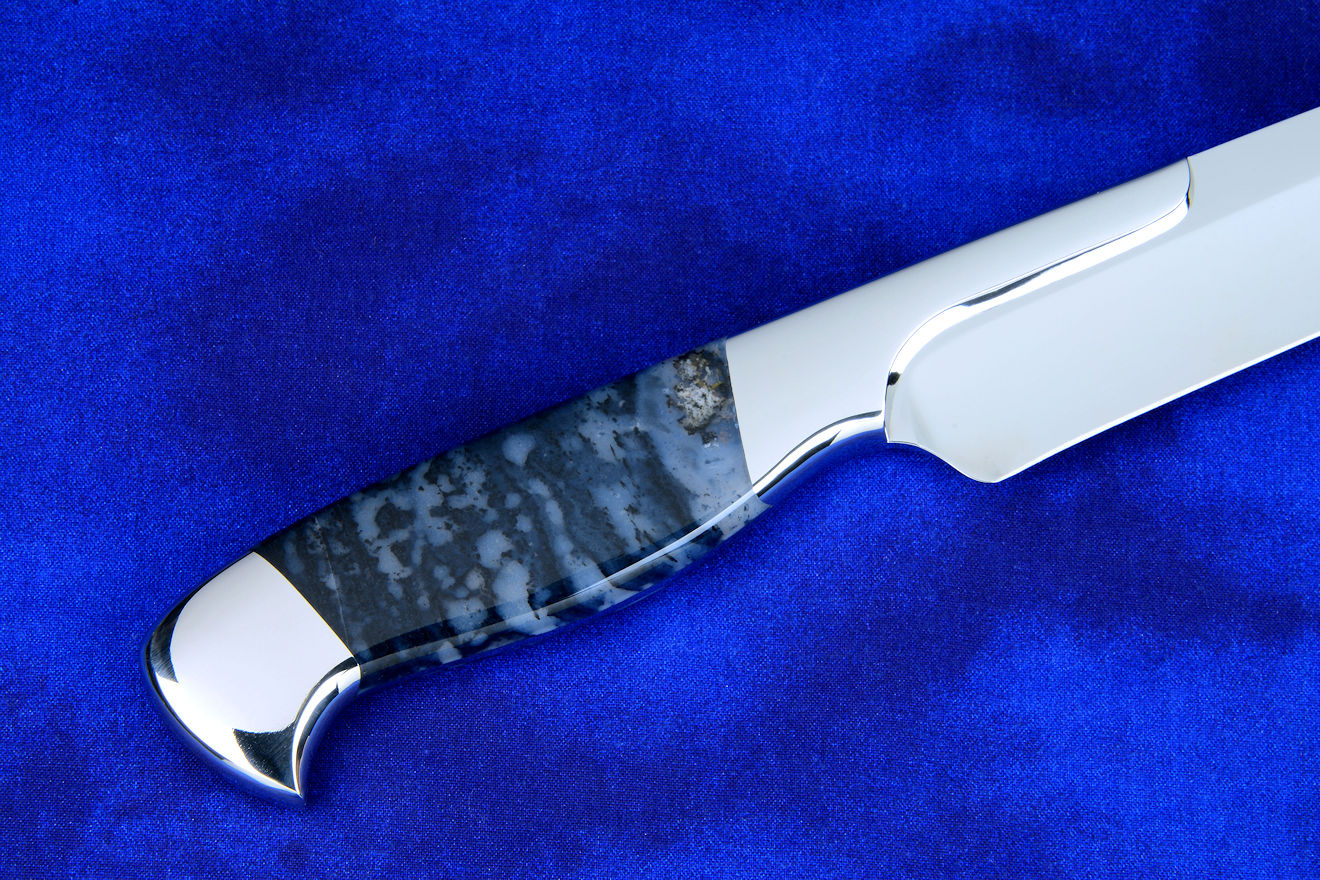
Hard, polished gemstone is the absolute finest premium natural handle material, and this choice was a natural. This is a very hard, tough, and beautiful stone, it's Night Leopard Agate from India. This is a solid agate, a cryptocrystalline quartz that is a 7 on the MOHS scale, very hard and solid. The gem has translucency in white cloudy areas, some blue-grays, and mossy or layered blacks. A beautiful stone that will literally outlast the knife, it's positively bedded and sealed to the tang, securely locked between and under the stainless steel bolsters. It's a zero-care stone, an eternal material with fascinating patterns.
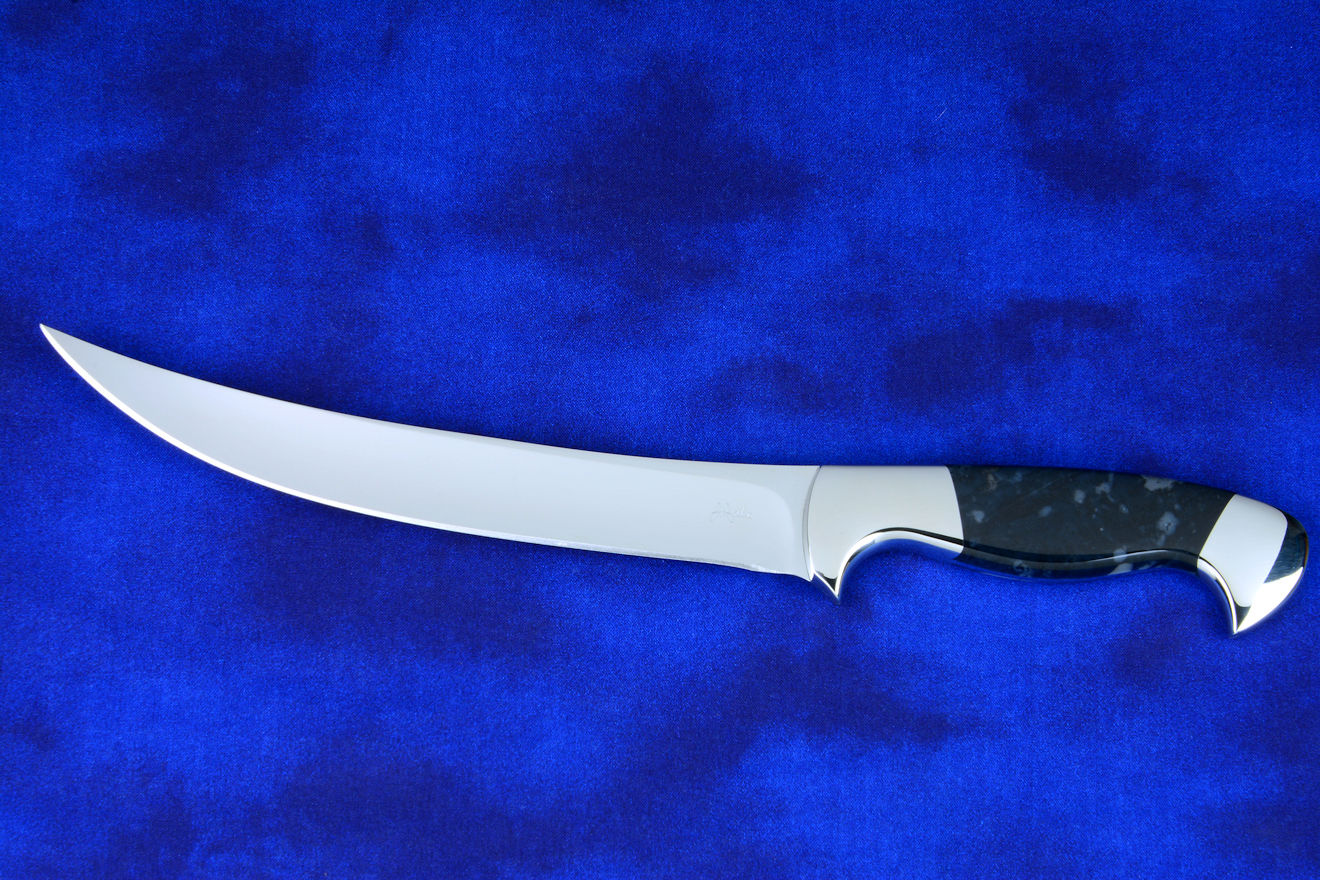
The Courbe trimming and boning knife is a quite different character than the Bordeaux, and this is why they make a great complimentary pair. Courbe is the French word for curve, and the flowing curvature of the blade is an elegant and useful design. Where the Bordeaux is stiff and strong with an incredibly thin, hard edge, the Courbe is a tougher character. I've tempered the T3 cryogenically treated steel at 57C Rockwell, which gives the blade some limited flexibility and great toughness. Just as with the Bordeaux, the Courbe is absolutely razor-sharp.
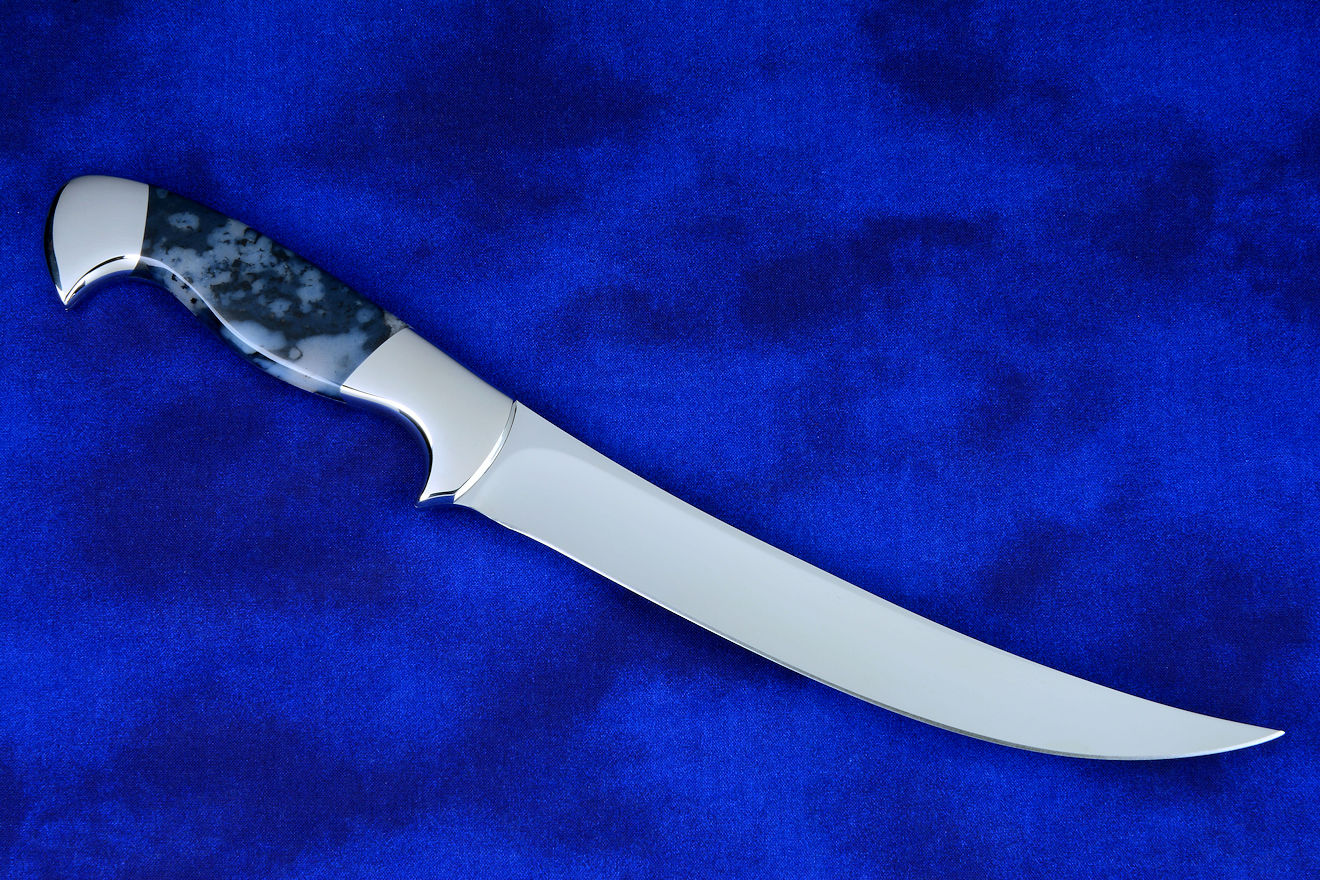
The Courbe has a thinner spine than the Bordeaux, at 0.100" (2.5 mm) but the thickness just behind the cutting edge is 0.028" (.7 mm) This is twice as thick as the Bordeaux, and it's these small adjustments in the geometry of knife blades that give them distinct and reliable functions. Aiding in this geometry is the choice of a 10" hollow grinding contact wheel for the best cross section for this size and shape of design. Because the Courbe is designed to be encountering bone, tough tissues, and reaching cuts, the blade had to be very tough. Also, since the blade profile is a trailing point (the point trails higher than the spine) additional width and support must be included so the tip is reinforced.
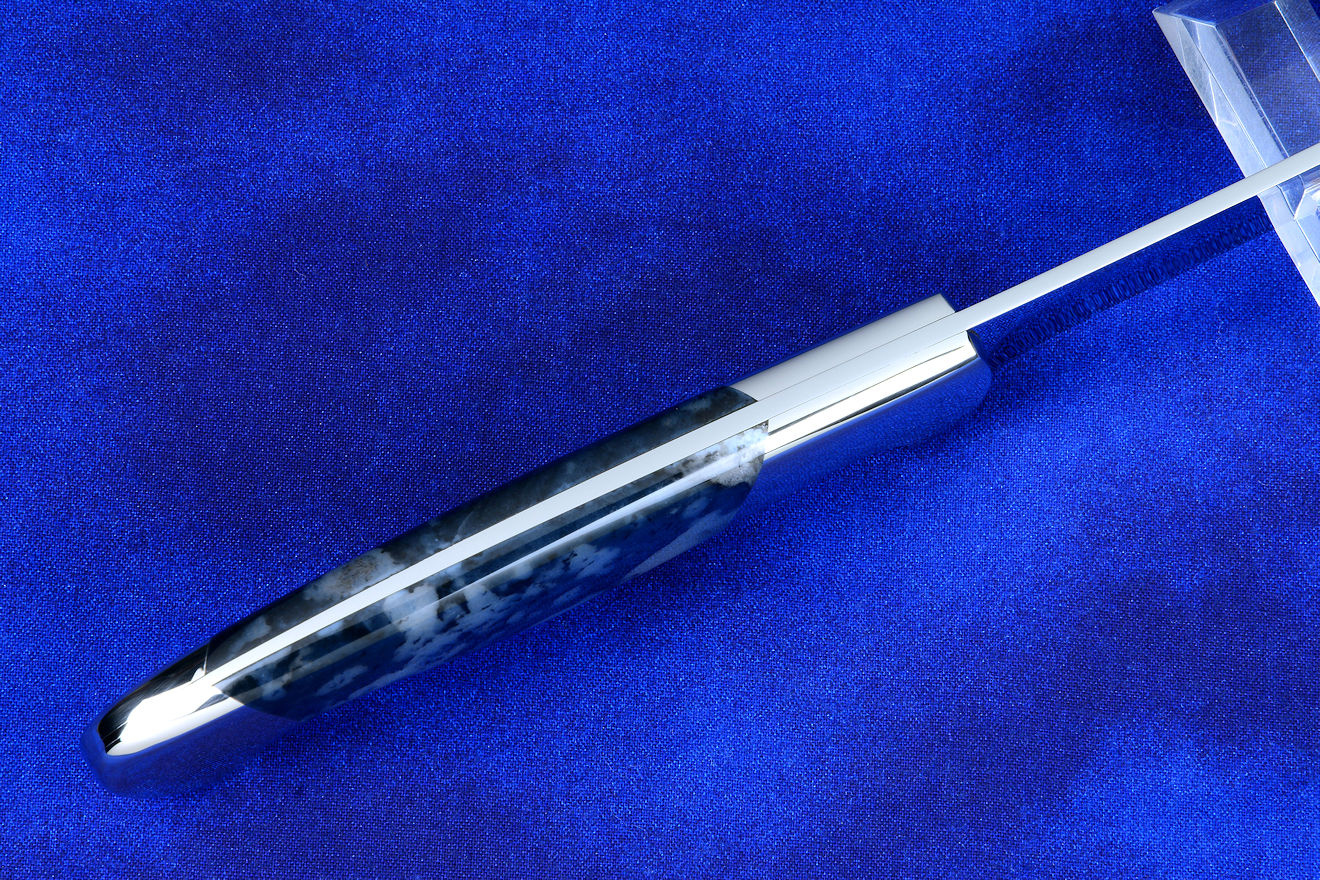
In the photo above, you can see that the knife has a fully tapered tang, which is always seen only on the very best full tang knives. It's difficult to make an accurate tapered tang, which helps reduce weight in the handle without sacrificing strength, balancing the knife overall, and always indicating handmade excellence. I chose to forego any filework that would trap foodstuffs and debris, making the knife comfortable to hold and tremendously easy to clean.
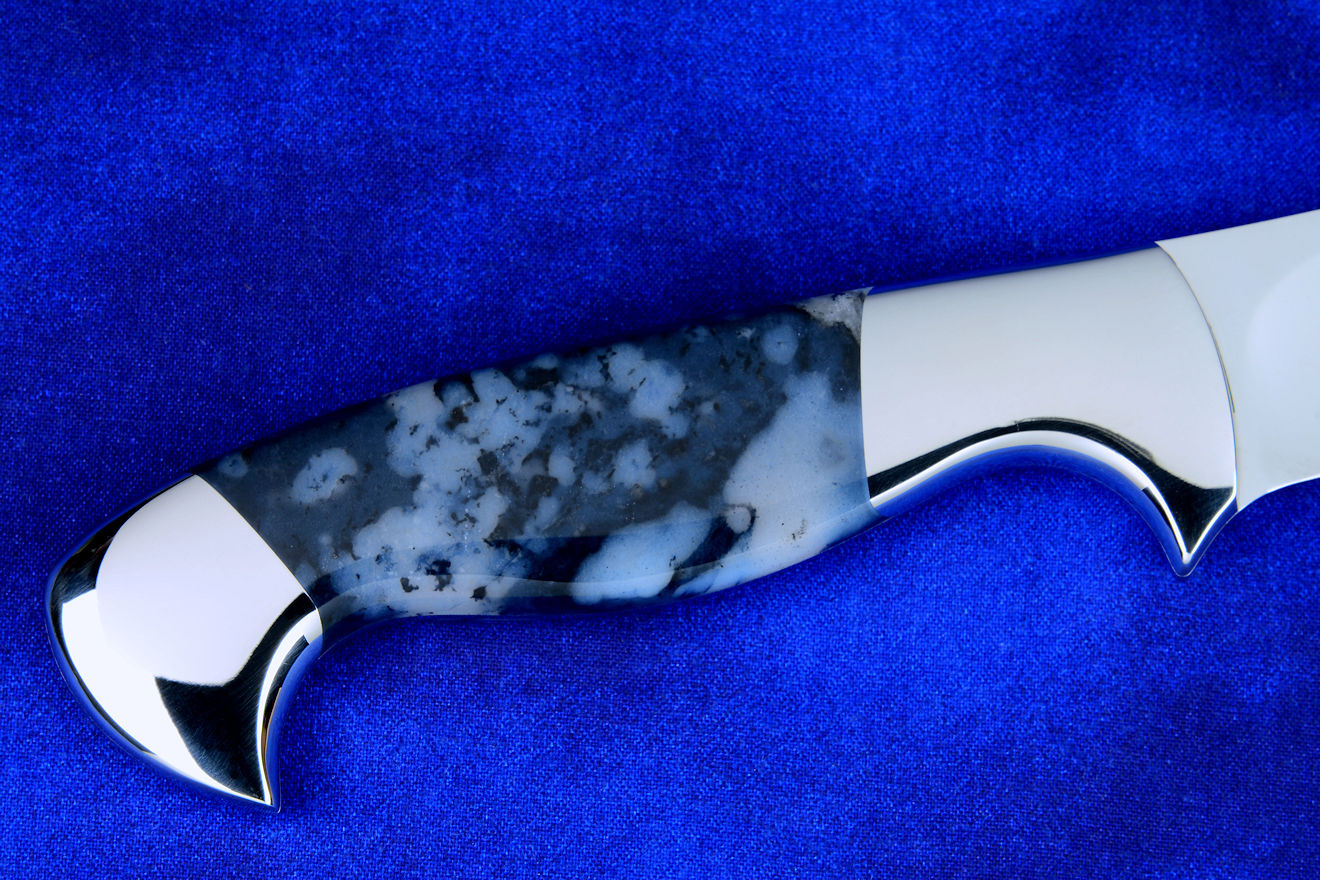
The Courbe has a deeply protective handle, with full forefinger quillon and rear hawk's bill with a prominent handle belly. This is a handle that locks securely into the hand for active use, with a high degree of protection from the cutting edge. As with the Bordeaux, the Courbe handle is beautiful, strong, tough, smoothly polished, locked to the tang. These knives will last for generations, and knowing that these gemstones will absolutely outlast the knife is the reason I love this eternal natural handle material.
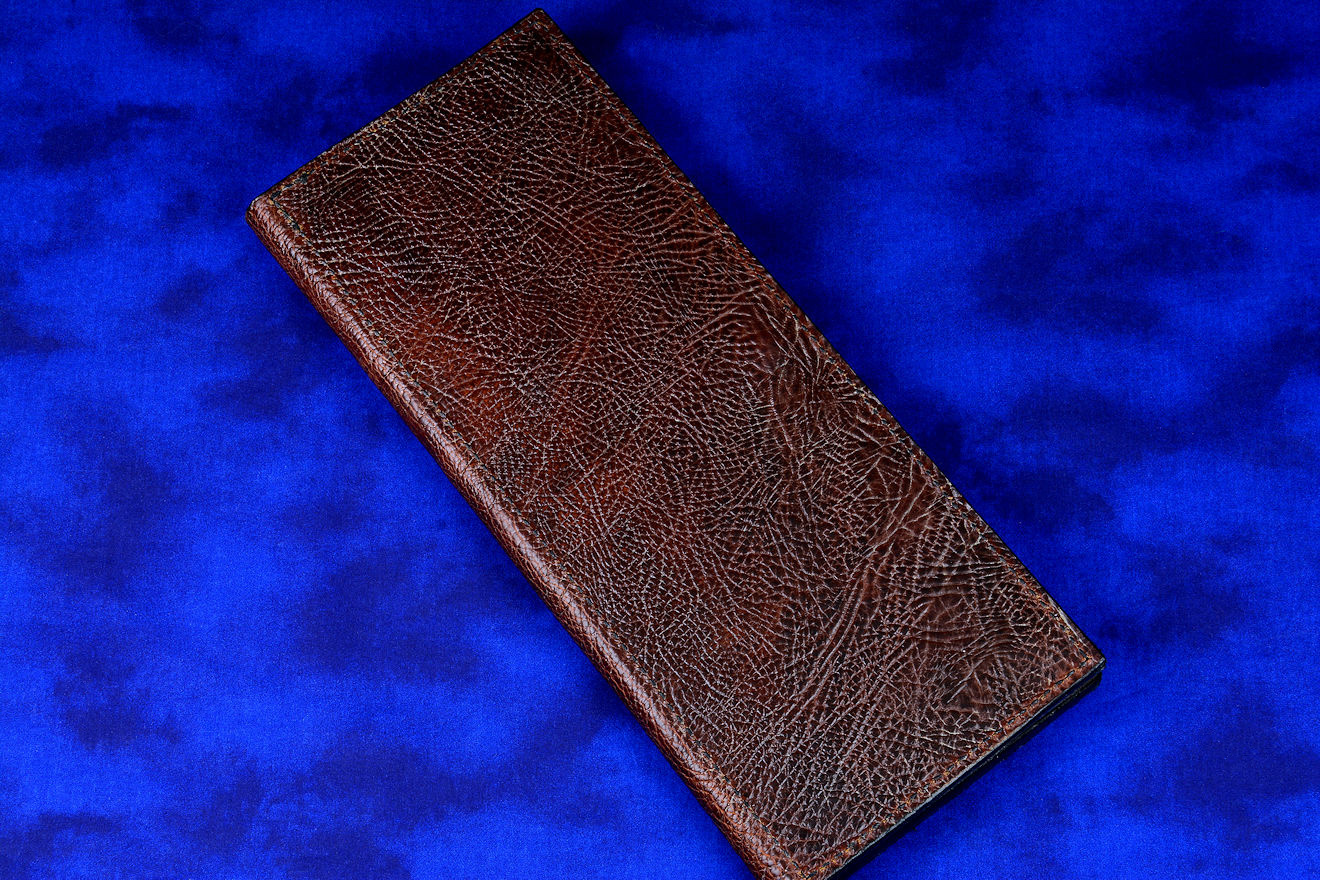
The case for the Bordeaux and the Courbe had to be complementary, useful, tough, and beautiful. You simply won't see anything else like it made; this is my commitment to the entire tradecraft and art of knifemaking. I made this case in multiple layers of heavy 9-10 oz. leather shoulder, bonded and stitched with strong, heavy nylon thread that allows a little flexibility and high strength. This is one of my "book" cases, and the knives rest in thick leather pockets, actually surrounded by leather, a true presentation grade case. The outer case is covered with Bison (sometimes called American Buffalo) skin, specially treated and wax-sealed. The Bison is tough and durable, beautiful and bold.

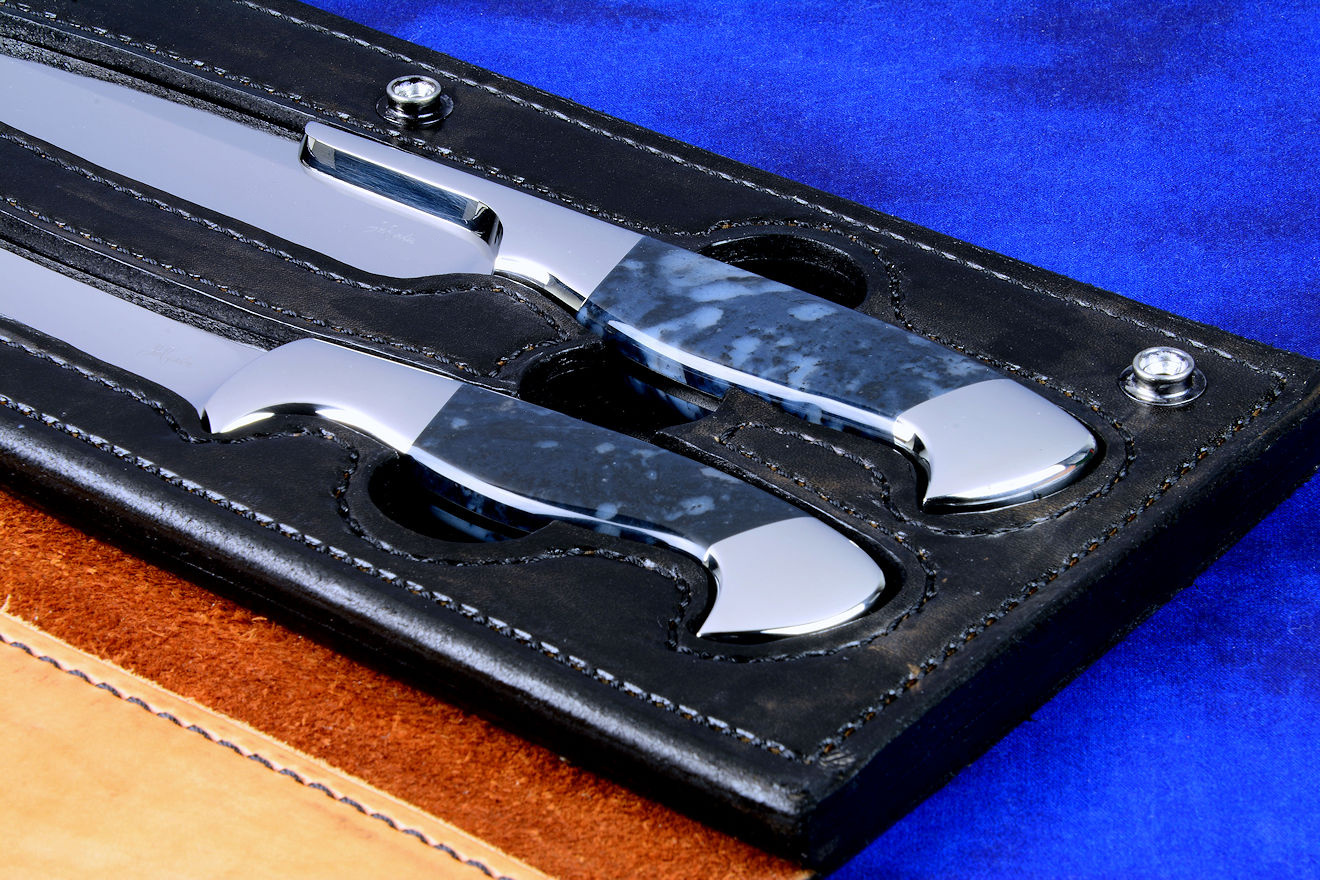
The case inside is dyed black, sealed with lacquer for longevity, and heavily bonded and stitched to the Bison cover. I've placed perfect finger grooves in just the right locations to facilitate removal of the knives. This tasteful and elegant book case will last for generations with little care. It's a secure case that is an ultimate classic presentation medium.
Please look over the many photos thumbnailed below the specifications for this pair of professional grade knives. I hope you enjoy looking at them as much as I enjoyed making this magnificent pair of knives!
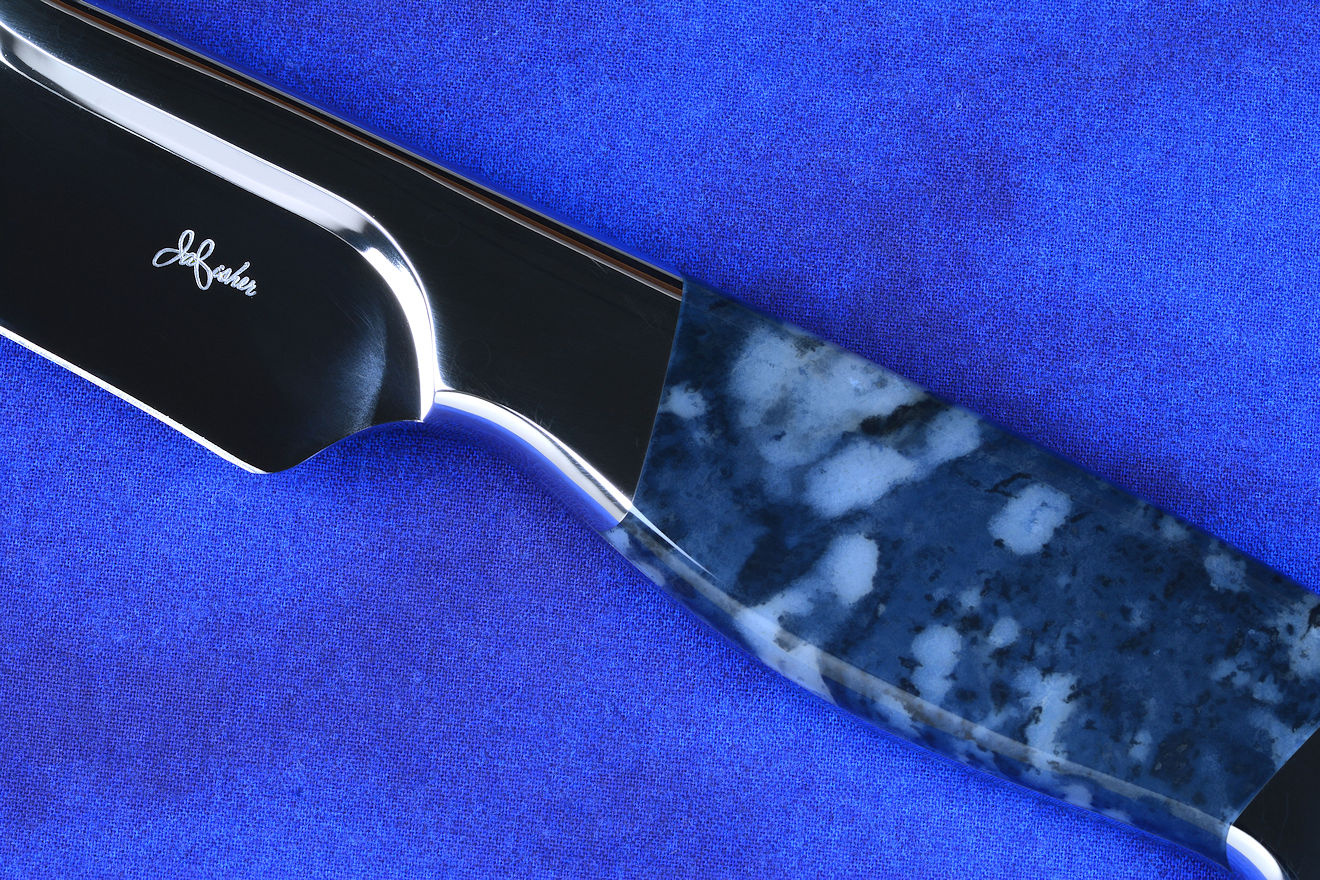
Thanks, S. H.!
| Main | Purchase | Tactical | Specific Types | Technical | More |
| Home Page | Where's My Knife, Jay? | Current Tactical Knives for Sale | The Awe of the Blade | Knife Patterns | My Photography |
| Website Overview | Current Knives for Sale | Tactical, Combat Knife Portal | Museum Pieces | Knife Pattern Alphabetic List | Photographic Services |
| My Mission | Current Tactical Knives for Sale | All Tactical, Combat Knives | Investment, Collector's Knives | Copyright and Knives | Photographic Images |
| The Finest Knives and You | Current Chef's Knives for Sale | Counterterrorism Knives | Daggers | Knife Anatomy | |
| Featured Knives: Page One | Pre-Order Knives in Progress | Professional, Military Commemoratives | Swords | Custom Knives | |
| Featured Knives: Page Two | USAF Pararescue Knives | Folding Knives | Modern Knifemaking Technology | My Writing | |
| Featured Knives: Page Three | My Knife Prices | USAF Pararescue "PJ- Light" | Chef's Knives | Factory vs. Handmade Knives | First Novel |
| Featured Knives: Older/Early | How To Order | Khukris: Combat, Survival, Art | Food Safety, Kitchen, Chef's Knives | Six Distinctions of Fine Knives | Second Novel |
| Email Jay Fisher | Purchase Finished Knives | Serrations | Hunting Knives | Knife Styles | Knife Book |
| Contact, Locate Jay Fisher | Order Custom Knives | Grip Styles, Hand Sizing | Working Knives | Jay's Internet Stats | |
| FAQs | Knife Sales Policy | Concealed Carry and Knives | Khukris | The 3000th Term | Videos |
| Current, Recent Works, Events | Bank Transfers | Military Knife Care | Skeletonized Knives | Best Knife Information and Learning About Knives | |
| Client's News and Info | Custom Knife Design Fee | The Best Combat Locking Sheath | Serrations | Cities of the Knife | Links |
| Who Is Jay Fisher? | Delivery Times | Knife Sheaths | Knife Maker's Marks | ||
| Testimonials, Letters and Emails | My Shipping Method | Knife Stands and Cases | How to Care for Custom Knives | Site Table of Contents | |
| Top 22 Reasons to Buy | Business of Knifemaking | Tactical Knife Sheath Accessories | Handles, Bolsters, Guards | Knife Making Instruction | |
| My Knifemaking History | Professional Knife Consultant | Loops, Plates, Straps | Knife Handles: Gemstone | Larger Monitors and Knife Photos | |
| What I Do And Don't Do | Belt Loop Extenders-UBLX, EXBLX | Gemstone Alphabetic List | New Materials | ||
| CD ROM Archive | Independent Lamp Accessory-LIMA | Knife Handles: Woods | Knife Shop/Studio, Page 1 | ||
| Publications, Publicity | Universal Main Lamp Holder-HULA | Knife Handles: Horn, Bone, Ivory | Knife Shop/Studio, Page 2 | ||
| My Curriculum Vitae | Sternum Harness | Knife Handles: Manmade Materials | |||
| Funny Letters and Emails, Pg. 1 | Blades and Steels | Sharpeners, Lanyards | Knife Embellishment | ||
| Funny Letters and Emails, Pg. 2 | Blades | Bags, Cases, Duffles, Gear | |||
| Funny Letters and Emails, Pg. 3 | Knife Blade Testing | Modular Sheath Systems | |||
| Funny Letters and Emails, Pg. 4 | 440C: A Love/Hate Affair | PSD Principle Security Detail Sheaths | |||
| Funny Letters and Emails, Pg. 5 | ATS-34: Chrome/Moly Tough | ||||
| Funny Letters and Emails, Pg. 6 | D2: Wear Resistance King | ||||
| Funny Letters and Emails, Pg. 7 | O1: Oil Hardened Blued Beauty | ||||
| The Curious Case of the "Sandia" |
Elasticity, Stiffness, Stress, and Strain in Knife Blades |
||||
| The Sword, the Veil, the Legend |
Heat Treating and Cryogenic Processing of Knife Blade Steels |